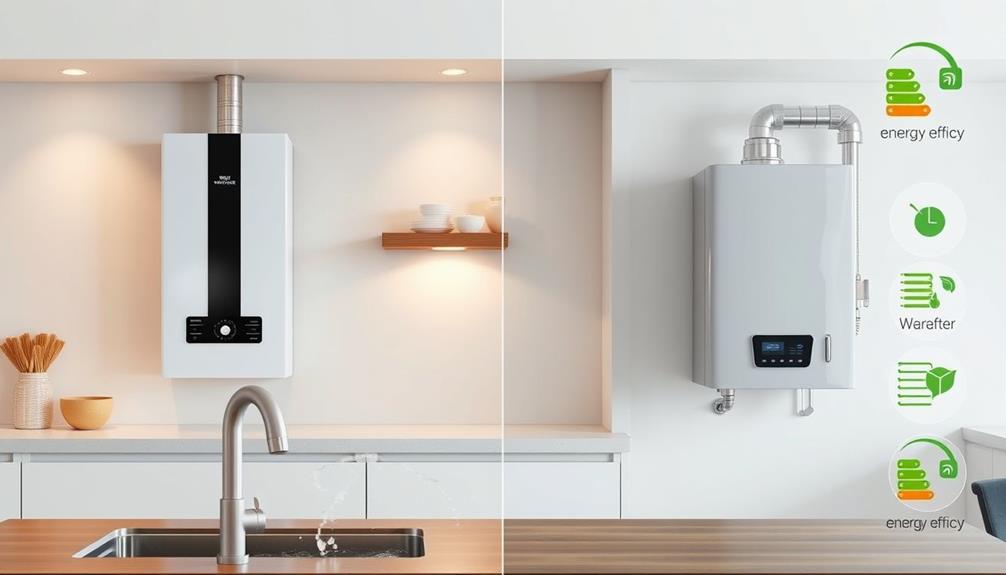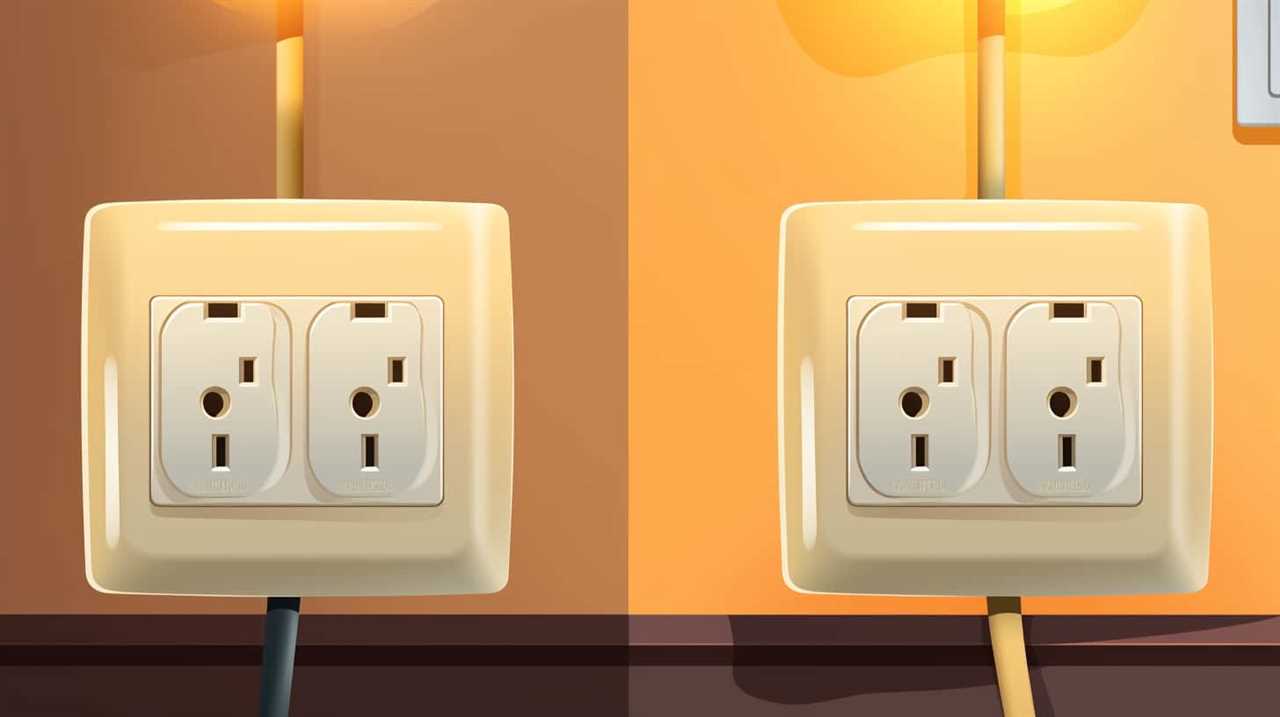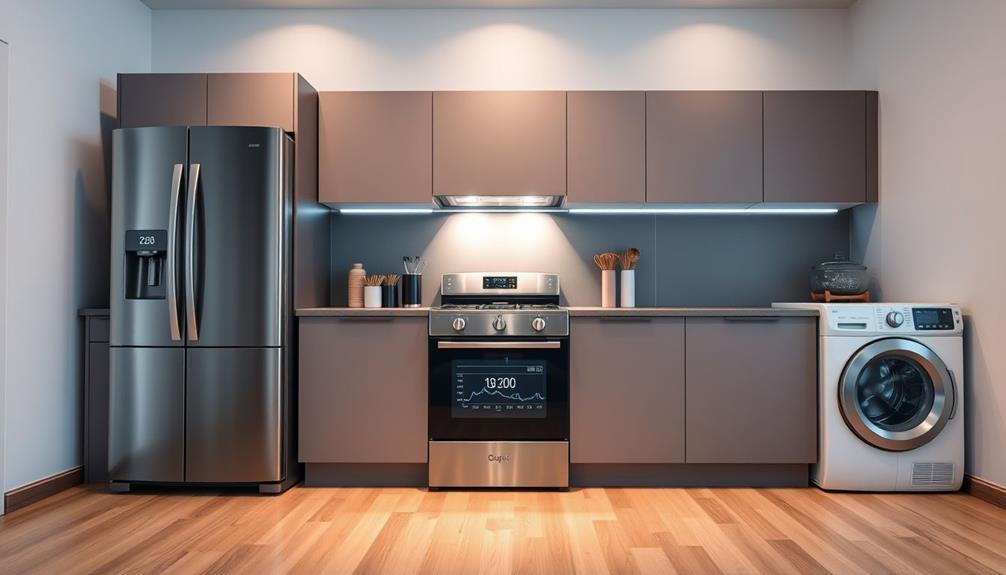Tankless water heaters provide a continuous supply of hot water when needed and are energy-efficient, resulting in a 24%-34% reduction in costs compared to traditional models. They are also durable, often lasting more than 20 years with proper upkeep. However, they do come with higher upfront expenses and larger households may require multiple units. Regular maintenance is necessary to prevent mineral buildup, and performance may be affected in colder climates. Considering these advantages and disadvantages will help you make an educated decision. For a better understanding of how tankless water heaters can be incorporated into your home, further exploration of their operation may be beneficial.
Key Takeaways
- Tankless water heaters provide endless hot water on demand, enhancing comfort and convenience for various household needs.
- They offer significant energy savings of 24%-34% compared to traditional models, reducing long-term costs.
- Installation can be complex and costly, requiring proper sizing and potential upgrades to existing plumbing or electrical systems.
- Regular maintenance is essential to prevent mineral build-up and ensure efficient operation, especially in hard water areas.
- The initial investment is higher, but a lifespan of over 20 years and potential rebates can justify the cost.
Overview of Tankless Water Heaters
When you're reflecting on your options for hot water, tankless water heaters might just be the solution you need. These units provide hot water on demand, eliminating the need for a bulky storage tank and considerably reducing standby energy losses.
With a flow rate of 1-5 gallons per minute (GPM), they can cater to various household sizes and hot water needs. Additionally, just as air purifiers improve indoor air quality, tankless water heaters enhance energy efficiency in your home.
Not only are tankless water heaters energy efficient, offering savings of 24%-34% compared to traditional storage models, but they also boast a longer lifespan, lasting 20 years or more with proper maintenance.
Available in both gas and electric options, they heat water instantaneously, which means you won't run out during a shower or while washing dishes.
However, it's crucial to assess the installation costs, as these can be higher than conventional systems.
Additionally, there are some disadvantages of tankless water heaters, such as the potential for limited hot water supply if multiple outlets are used simultaneously.
Weighing these pros and cons will help you determine if a tankless system fits your home's hot water requirements.
Installation Considerations

When considering a tankless water heater, you'll need to size it correctly to meet your household's peak hot water demands.
Garage door openers can enhance home security and provide modern technology, much like how tankless systems improve efficiency.
Installation complexity can vary based on your home's existing plumbing, gas, or electrical systems, which might require upgrades.
It's essential to evaluate these factors to guarantee you choose the right unit and avoid unexpected costs down the line.
Sizing for Demand
Proper sizing of your tankless water heater is vital for meeting your household's hot water demands effectively. To determine the right size, you'll need to assess your peak hot water demand, which varies based on daily activities. Flow rates typically range from 1 to 5 gallons per minute (GPM), so consider how many fixtures you might use simultaneously.
If you have a larger household or experience simultaneous high-demand usage, like multiple showers or washing machines running at once, you might require multiple tankless units to guarantee an adequate supply. Additionally, understanding your household's specific needs can be compared to factors when choosing key factors in hiring a service for your maintenance.
In colder climates, a higher temperature rise may be necessary, impacting the unit's efficiency and heating time. This factor should also be included in your sizing calculations.
Furthermore, upgrading existing plumbing, gas lines, or electrical systems might be necessary for proper installation and maintenance, which can influence your overall tankless water heater costs.
To make the best choice, getting a professional assessment of your current setup is critical. They can help you determine the most suitable size and installation approach for ideal performance and efficiency, guaranteeing you won't run out of hot water when you need it most.
Installation Complexity Factors
Installing a tankless water heater can be quite complex, often requiring professional expertise to navigate the intricacies of retrofitting your existing plumbing and electrical systems. This complexity can considerably increase your upfront cost.
Depending on the type of unit you choose, you might need to upgrade gas lines or electrical wiring to meet the unit's requirements, which adds to the overall installation challenge. Additionally, guaranteeing proper ventilation during use is vital for gas appliances, especially in confined spaces, as improper ventilation can lead to safety hazards safety precautions necessary.
The location of your home also plays a key role; if you live in a colder climate, you may need extensive upgrades to guarantee efficient heating, as the incoming water temperature directly affects performance.
If your household has high hot water demand, you might need multiple tankless units to maintain adequate flow rates, further complicating the installation process and driving up costs.
Proper sizing of the tankless heater is imperative to avoid insufficient hot water supply. An undersized unit can lead to frustrations, so it's important to consult a professional plumber for accurate assessments.
Ultimately, while the promise of energy savings is appealing, be prepared for the complexities that come with installation.
Energy Efficiency Benefits
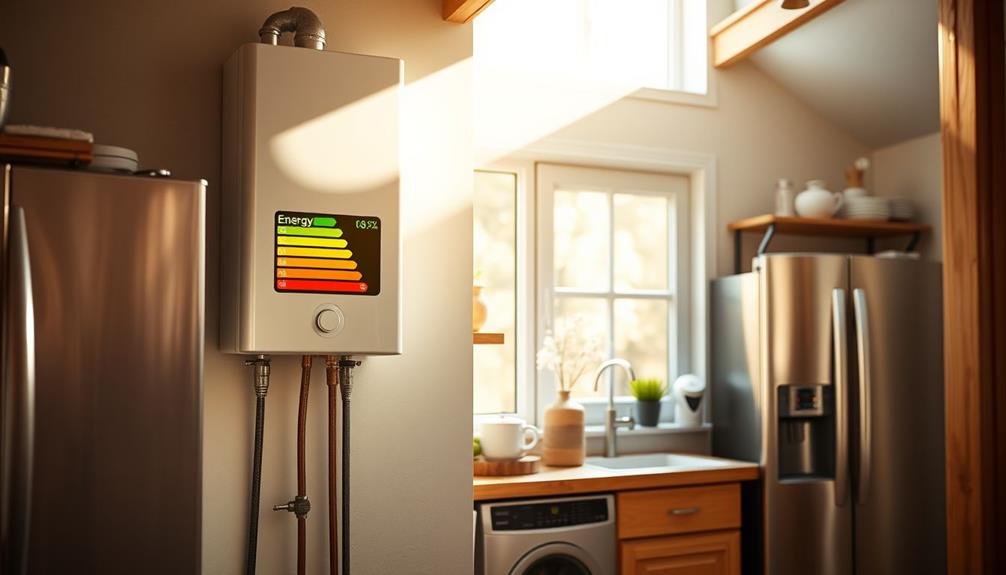
One of the standout advantages of tankless water heaters is their impressive energy efficiency. Unlike traditional storage tank models, which constantly heat water and suffer from standby heat loss, tankless water heaters heat water on demand. This can make them 24% to 34% more energy-efficient for households using 41 gallons of hot water or less daily.
Geothermal energy systems also offer considerable energy savings, highlighting the potential of various eco-friendly solutions. You could see energy savings of up to 50% if you opt for multiple units.
Tankless systems boast energy factor ratings ranging from 80% to 99%, considerably reducing fuel consumption and lowering your greenhouse gas emissions. Even though these systems may have a higher upfront cost, the long-term energy savings can make them a smart investment, with payback periods typically between 10 to 25 years.
Additionally, many tankless models qualify for Energy Star ratings, which not only indicates their efficiency but can also lead to potential tax credits or rebates.
Cost Implications
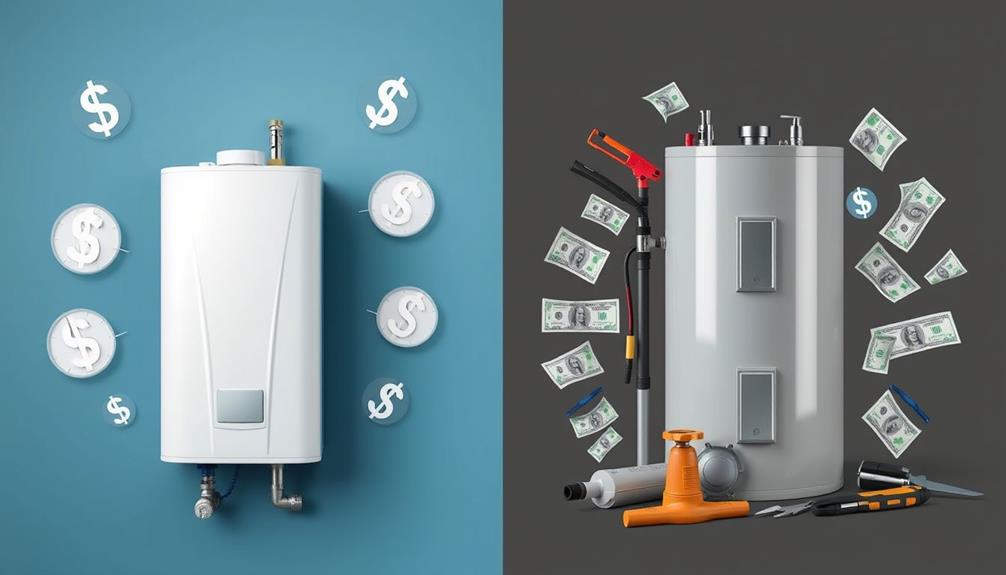
While the energy efficiency of tankless water heaters is a major draw, it's important to take into account the cost implications as well. The initial cost for these units can range from $1,000 to $3,000, often two to three times higher than traditional tank heaters, which typically cost around $900.
You'll also need to factor in installation costs, which can add another $500 to $1,500, depending on any necessary upgrades to your plumbing or electrical systems. Additionally, considering the long-term benefits of energy efficiency, many homeowners find that these systems align with their goals for sustainable living, similar to the way setting realistic weight loss goals can maintain motivation during challenges.
Though these upfront investments may seem intimidating, you could benefit from energy savings over time, with payback periods stretching between 10 to 25 years, depending on your usage.
Fortunately, financial incentives like federal rebates of 30% on project costs can greatly reduce your initial investment, averaging around $600. Don't forget, regular maintenance costs for tankless systems typically range from $45 to $200 annually, which is an ongoing consideration for your overall financial planning.
Ultimately, weighing the initial and ongoing costs against the potential savings will help you decide if a tankless water heater is the right choice for your home.
Advantages of Continuous Hot Water
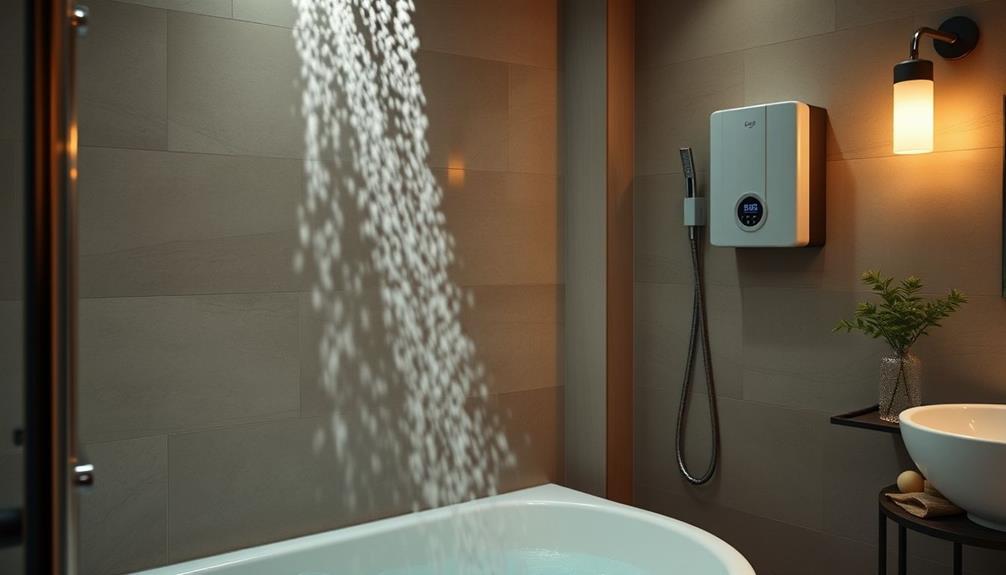
Imagine enjoying uninterrupted hot water whenever you need it—tankless water heaters make that a reality. These innovative systems provide an endless supply of hot water, allowing you to indulge in long showers or fill bathtubs without worrying about running out.
With tankless water heaters, you can enjoy on-demand hot water that keeps flowing, even during peak usage times. Unlike traditional systems, these heaters have considerably lower risks of plumbing issues, such as clogged toilet solutions, making them a reliable choice for modern households.
One of the standout advantages of tankless systems is their ability to support simultaneous use of multiple hot water sources. This makes them perfect for larger households where several appliances might be in operation at once, like running the dishwasher while someone's taking a shower.
Unlike traditional tank systems, which take time to refill and reheat, tankless heaters deliver hot water instantly, ensuring you won't face any frustrating waiting times.
Moreover, tankless water heaters maintain a consistent temperature throughout your daily routines, eliminating those annoying cold water surprises. With the capability to heat water indefinitely during use, these systems cater to your continuous hot water needs, making them a smart choice for homes with high hot water demands.
Enjoy the convenience and comfort that continuous hot water provides with tankless technology!
Limitations of Tankless Systems
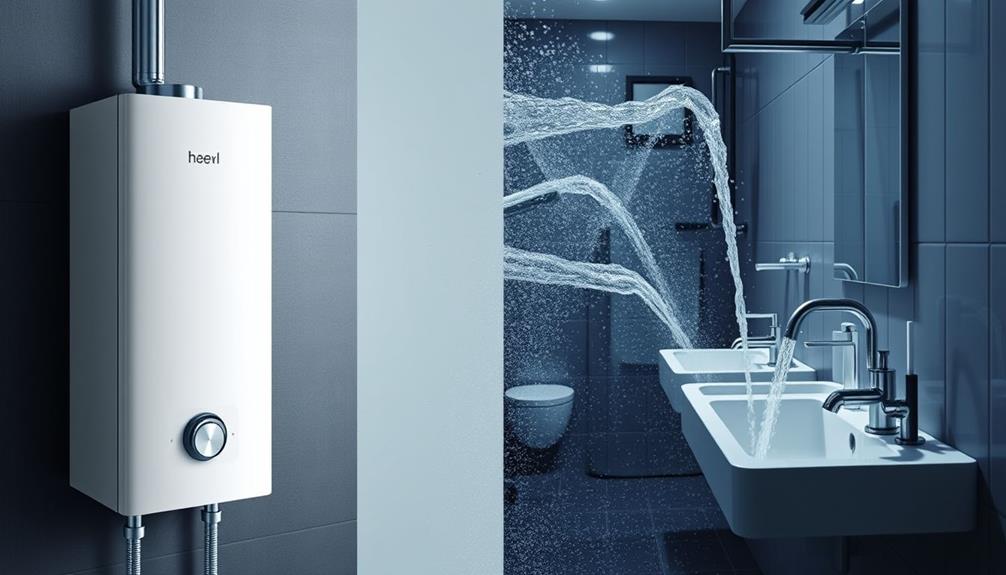
Though tankless water heaters offer many benefits, they also come with limitations that can affect their performance in certain situations. One key drawback is the limited flow rate, typically providing between 1-5 gallons per minute. This may not suffice for homes with multiple hot water demands happening at once, leading to potential temperature fluctuations.
For instance, if you have several showers running simultaneously, a single tankless system might struggle to keep up, requiring you to install multiple units for larger households. Additionally, while cooking and baking with butter, ideal temperatures can enhance performance, similar considerations for temperature apply to tankless water heaters in colder climates.
In colder climates, incoming water temperatures can extend heating times, causing longer waits for hot water and possibly impacting efficiency. Additionally, tankless systems depend on electrical power to operate, meaning that your hot water supply will cease during power outages, which can be a significant drawback in areas prone to such interruptions.
Regular maintenance is essential for best performance, especially in hard water areas where mineral build-up can occur. Without annual descaling, your tankless system may not perform effectively over time.
Being aware of these limitations can help you determine if a tankless water heater is the right choice for your home.
Maintenance Requirements
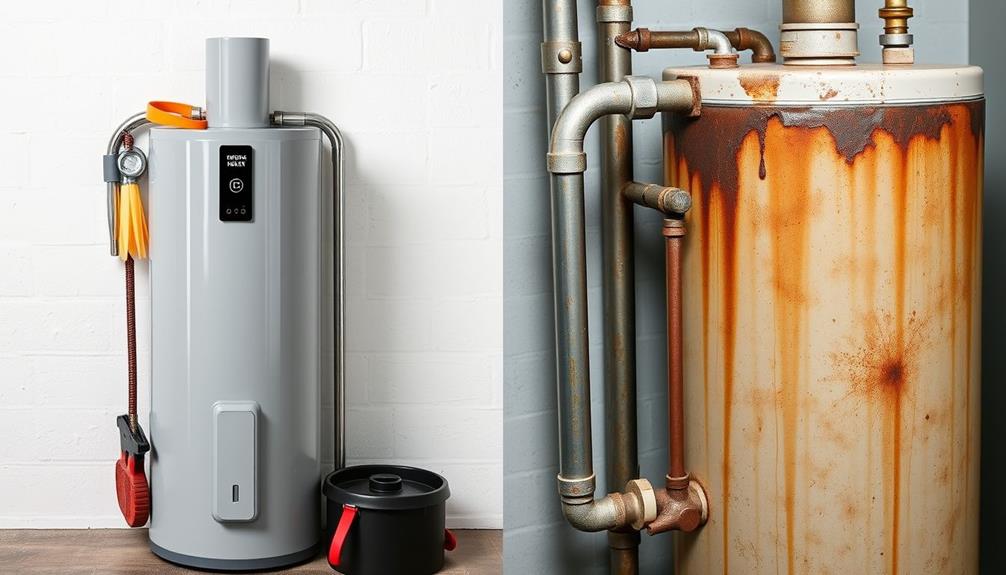
Maintaining your tankless water heater is essential for its longevity and efficiency.
Regular upkeep can enhance its performance, similar to the importance of stress management techniques for overall health.
You'll need to perform routine tasks, like cleaning the air and water filters every few months, especially if you live in an area with hard water.
Flushing the system annually—or more often if needed—will help prevent mineral buildup and keep everything running smoothly.
Routine Maintenance Tasks
Routine maintenance is essential for keeping your tankless water heater running efficiently. To achieve ideal performance, you should plan to perform descaling at least once a year. If you live in an area with hard water, consider flushing the system twice a year to prevent mineral build-up.
The flushing process typically involves using a vinegar solution to remove sediment accumulation, which can greatly affect the unit's heating efficiency and lifespan. Additionally, adopting a healthy lifestyle can positively impact your overall energy usage and efficiency in the home, including how you manage your appliances.
In addition to descaling, it's important to clean the air and water filters every 4-6 months. This simple task helps maintain ideal performance and guarantees your heater operates at peak efficiency.
Neglecting these routine maintenance tasks can lead to reduced efficiency, potential overheating, and even an increased risk of scalding due to improper temperature regulation.
If you're not comfortable performing these tasks yourself, you can always opt for professional servicing. Costs for professional maintenance can range from $45 to $200 annually, depending on the complexity of the tasks involved.
Investing in routine maintenance not only extends the life of your heater but also enhances its performance, keeping your hot water flowing smoothly.
Hard Water Considerations
Hard water can pose considerable challenges for tankless water heaters, making regular maintenance even more critical.
Mineral build-up from hard water can greatly reduce the efficiency and lifespan of your system if not addressed. You'll want to schedule regular descaling at least once a year, but if you live in an area with hard water, consider doing it twice a year. Ignoring this maintenance can lead to costly repairs, with descaling services averaging between $45 and $200 annually.
Additionally, hard water can cause overheating issues in tankless water heaters. If mineral deposits block the heat exchanger, it increases the risk of scalding, making it essential to keep an eye on your system's performance.
Installing water softeners or filters can help mitigate the damaging effects of hard water and lower the frequency of maintenance needed.
Ultimately, staying proactive about maintenance will guarantee your tankless water heater runs efficiently and safely. Regular descaling and monitoring can prevent the complications that come with hard water, safeguarding your investment and enhancing your home's hot water supply.
Lifespan and Durability
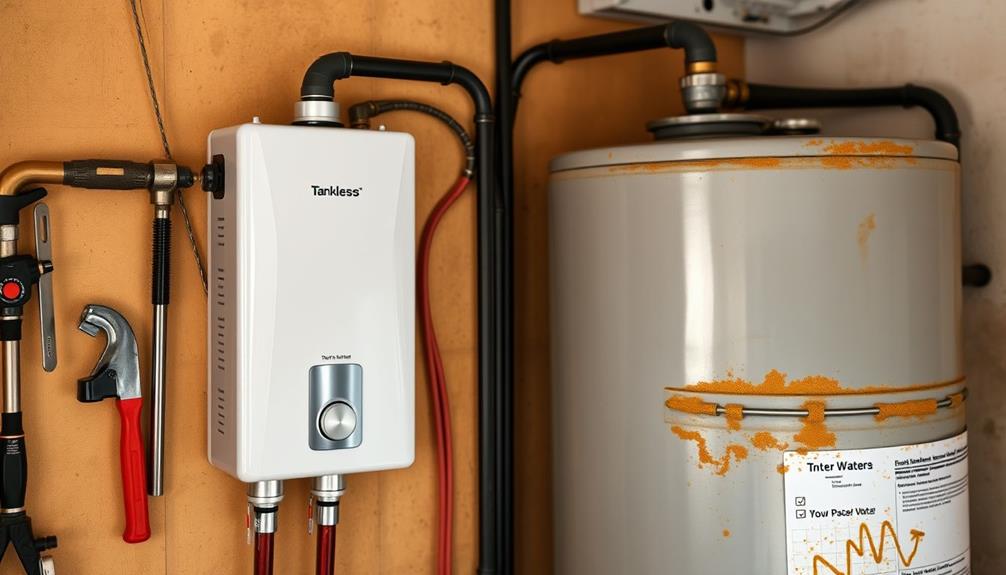
When considering a water heating system, the lifespan and durability of tankless water heaters stand out as significant advantages. Unlike traditional storage tanks, which typically last only 8-15 years, tankless models can easily exceed 20 years of reliable service. This longevity makes them a worthwhile investment for homeowners seeking long-term solutions.
The durability of tankless heaters stems from their unique design, which minimizes the risk of rust and corrosion often seen in tank models. With fewer components susceptible to wear and tear, these systems are built to last.
Regular maintenance, such as descaling to prevent mineral buildup, can further enhance their lifespan, ensuring your system operates efficiently over time.
Many high-quality tankless water heaters also come with extended warranties, a demonstration of their manufacturers' confidence in their durability. This assurance can provide peace of mind, knowing you're investing in a product designed for the long haul.
Top Tankless Water Heater Brands
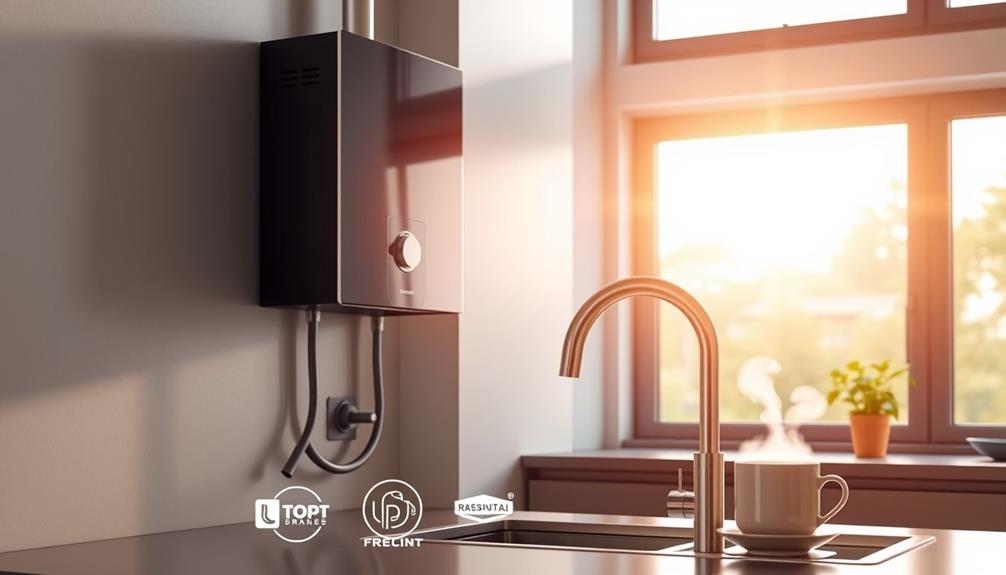
Choosing the right tankless water heater can greatly impact your home's efficiency and comfort, and several top brands stand out in the market. Here's a quick overview of the leading options you might consider:
| Brand | Key Features |
|---|---|
| Rinnai | Reliable gas models, longevity |
| Rheem | Easy installation, gas/electric |
| Noritz | Advanced technology, durability |
| Stiebel Eltron | Compact electric models |
| Bosch | Strong reputation, energy efficiency |
When you're deciding on tankless water heaters, you'll find that brands like Rinnai are popular for standard household needs, while Rheem offers a versatile range of gases and electric models. Noritz is known for its innovation as the first manufacturer of tankless systems, ensuring reliable hot water supply. Stiebel Eltron excels with its efficient, space-saving electric models, ideal for smaller homes. Finally, Bosch combines quality with energy efficiency, making it a trusted choice.
Making the Right Choice
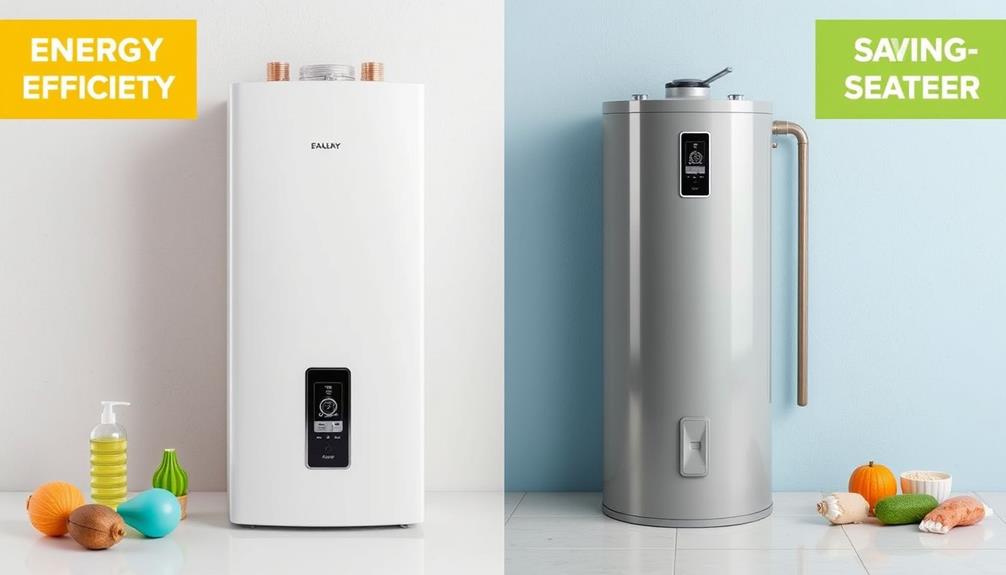
When you're deciding on a tankless water heater, it's essential to assess your hot water needs and how many gallons per minute you require.
You'll also want to evaluate installation costs, as they can vary greatly, and consider the long-term energy savings that these systems offer.
Assessing Hot Water Needs
Evaluating your household's hot water needs is imperative to selecting the right tankless water heater. Start by gauging your peak hot water demand. Tankless water heaters typically deliver between 1-5 gallons per minute (GPM), so it's essential to determine if a single unit can handle simultaneous usage of high-flow fixtures like showers and washing machines.
You should also consider the climate in your area. Colder temperatures can lower incoming water temperature, affecting the heater's efficiency and performance.
Next, evaluate your current plumbing systems to verify they can support a tankless installation. Necessary upgrades may increase installation costs and complicate the process.
Calculate your household's expected usage patterns to guarantee that your chosen unit meets your specific demands. Larger homes or those with high simultaneous usage might require multiple units.
Consulting with professionals can help you accurately size the tankless heater based on your family's hot water needs. This step is significant to avoid potential flow rate limitations that could lead to temperature fluctuations during high-demand periods.
Evaluating Installation Costs
Installing a tankless water heater can be a significant investment, with initial costs ranging from $800 to $3,500, which is particularly higher than the average cost of traditional tank-style heaters.
When evaluating installation costs, it's crucial to examine not just the price of the unit itself, but also the necessary professional installation, which can add another $500 to $1,500.
Upfront expenses may increase if your home requires plumbing upgrades, gas line modifications, or electrical system adjustments, especially if you're moving away from a tank system. These factors can quickly inflate your budget.
You'll also want to assess your household's hot water demand; undersized units may necessitate multiple installations, further impacting your overall costs.
While the initial investment for tankless water heaters can be intimidating, remember that financial incentives, like federal rebates of up to 30%, can help offset some of these expenses.
Long-Term Energy Savings
Long-term energy savings are one of the most compelling reasons to contemplate a tankless water heater. These systems can provide energy savings of 8%-50% compared to traditional storage tank heaters, which can greatly reduce your energy bills over time.
While the investment upfront for tankless models may be higher—sometimes up to three times that of conventional heaters—the long-term savings often justify the expense.
With their on-demand heating capabilities, tankless systems eliminate standby energy losses, meaning you won't waste energy heating water that isn't being used. In high-energy-cost areas, this efficiency can quickly offset the initial costs, making it a financially sound choice for homeowners.
Moreover, many energy-efficient tankless models may qualify for financial incentives or rebates, further enhancing their long-term cost-effectiveness.
The typical payback period for these systems ranges from 10-25 years, ensuring that you'll see returns on your investment over time.
If you're seeking an efficient water heating solution that delivers substantial long-term savings, switching to a tankless water heater could be the right decision for you.
Frequently Asked Questions
What Is the Downside of Tankless Water Heaters?
Tankless water heaters can struggle during peak demand, leaving you without enough hot water. They often require higher upfront costs, have limited flow rates, and need regular maintenance, which can complicate ownership and increase expenses.
Why Avoid a Tankless Water Heater?
Imagine a river that runs dry during drought; you wouldn't rely solely on it for survival. Similarly, avoiding tankless water heaters might be wise, as their limitations could leave you without hot water when you need it most.
Is It Worth Switching to a Tankless Water Heater?
Switching to a tankless water heater can be worth it if you value energy savings and endless hot water. Just consider your upfront costs and maintenance needs to guarantee it fits your budget and lifestyle.
Can I Replace My 40 Gallon Water Heater With a Tankless Water Heater?
You can replace your 40-gallon water heater with a tankless unit, but verify it's sized correctly for your needs. Consider installation costs and any plumbing modifications before making the switch for maximum efficiency.
Conclusion
In the end, tankless water heaters offer a compelling mix of benefits and challenges. You'll enjoy endless hot water and energy savings, but upfront costs and installation can be a hurdle. While they boast impressive durability and require less maintenance, they might not be the best fit for every home. By weighing these pros and cons, you can make an informed choice that fits your lifestyle and budget, ensuring your comfort for years to come.
